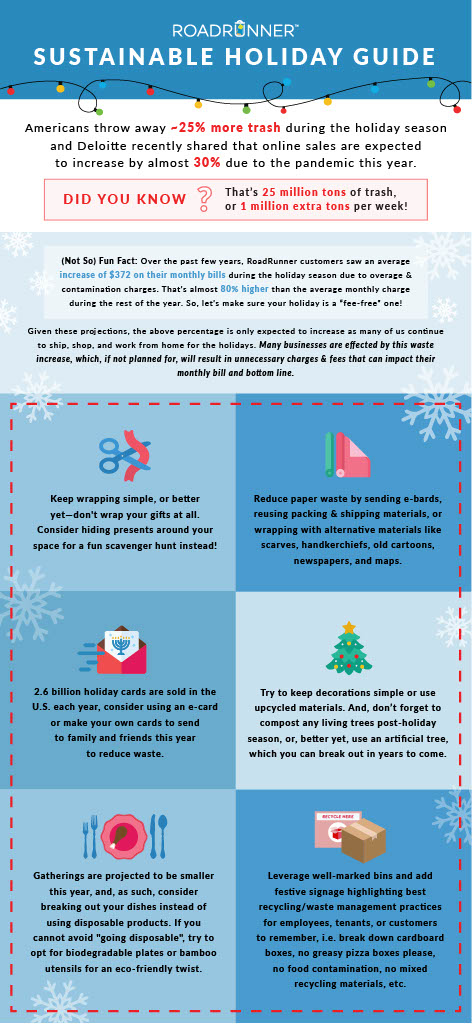It likely comes as no surprise that people generate more waste during the holidays than any other time of year—25 percent more to be exact. And given the unexpected circumstances that 2020 brought with it this year, that percentage isn’t expected to decrease any time soon. If anything, with all the online shopping, deliveries, and takeout orders, we’re likely to see an increase in holiday waste generation.
It's also worth noting that we're already deep into prime “waste generation season,” which falls between Thanksgiving and New Years, annually. So we thought it would be helpful to share not just the staggering facts about holiday waste, but also some helpful solutions to reduce waste (and hopefully recycle more) during this time and beyond.
Before sharing more about the landscape of holiday waste, consider that reducing waste at your business or home doesn’t just positively impact the environment, but can also help save money by lowering recurring expenses. The reason for this is when unexpected waste increases occur, typical vendors can be required to service your location more frequently, or pick up a lot more trash than what was agreed upon in a waste contract—often resulting, most commonly, in overage charges and unexpected fees.
That’s why it’s important to not only anticipate when waste increases may occur for your business, but also work with a waste and recycling hauler that makes it easy to change service frequencies, add new streams as needed (e.g. cardboard, mixed paper, etc.), and help you avoid unnecessary charges when possible.
All that said, please see some key stats below to put the increase in holiday waste into perspective and check out our sustainable holiday infographic for tips on how you can reduce waste this season and into next year!
QUICK HOLIDAY FACTS
Here are just a few facts to better understand what kind of waste is generated during this season and, perhaps, get some wheels turning about areas to focus on when trying to have a more eco-friendly holiday.
#1: WASTED FOOD
According to Unilever, 4.2 million Christmas dinners were wasted in the United Kingdom during one holiday season. Imagine approximately that amount being multiplied by all the countries that contribute to food waste during the holidays each year.
#2: TURKEYS & TREES
Approximately 2.2 million turkeys and 6 million trees go to waste each year. And, with many of those materials being thrown in the trash, this means contributing to the release of methane and carbon dioxide into the air. According to the Carbon Trust one, live, six-foot-tall tree accounts for 35 pounds of carbon dioxide, which if sent to landfill directly contributes to unwanted toxins released into our environment.
#3: RIBBON
If all families were to reuse just two feet of holiday ribbon, that would account for 38,000 miles ribbon saved—Another way to look at it is that we throw away enough ribbon each year to wrap around the entire planet.
6 SUSTAINABLE HOLIDAY TIPS
View the infographic for some ideas to stay eco-friendly during this winter season.

Click on the infographic to save the PDF version to reference yourself or share with colleagues & friends!
HAVE A HAPPY & SUSTAINABLE HOLIDAY
We hope the above facts and infographic guide were helpful in giving you ideas to reduce waste and be environmentally-friendly this season and well into 2021.
If you’re a business looking for a partner to better manage your waste & recycling, with sustainability and cost savings top of mind, RoadRunner is always here to help. For more information about our services, you can reach out to us here.
Lastly, and as always, feel free to leave a comment with any helpful sustainability tips you’re following to keep your holiday season "green". Until next time, stay well and thanks for reading! 🌲 ✨ ♻️
